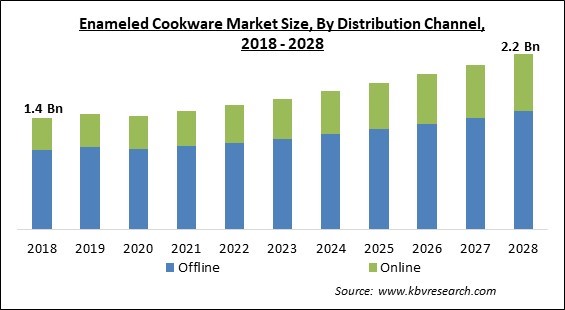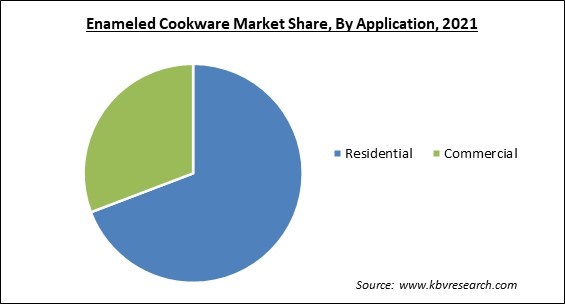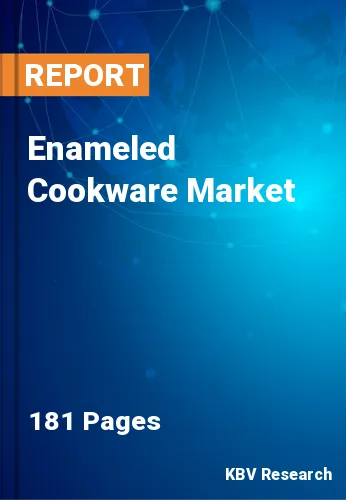The Global Enameled Cookware Market size is expected to reach $2.2 billion by 2028, rising at a market growth of 5.9% CAGR during the forecast period.
Enamel cookware is essentially kitchenware that has a coating of enamel as the topmost surface. Metals like cast iron, copper, aluminum, and stainless steel are the base materials of enamel cookware. The enamel used to coat metal objects is classified as vitreous enamel. Metals with varying degrees of reactivity are protected from scarring and searing by meals. Enamel is smooth, strong, and robust, creating a solid barrier that ensures the safety and longevity of the equipment.

The enamel coating is produced by firing glass powder at extremely high temperatures to create a viscous fluid, which is then applied to a metal surface and allowed to cool to form a smooth, hard protective layer. Enamel technology has existed for centuries and with the evolution of chemistry and technology, enamel cookware has made a greater effect on cooks and chefs around the world.
Enamel is a vibrant material in terms of coloration. Initially, blue enamelware was the most prevalent color, but in recent times, green, yellow, white, red, and orange enamelware has emerged, depending on the enamel type and chemical properties used. The impact of various colors of enamel cookware lends vibrancy to any house or kitchen. Interestingly, multicolored enamel cookware can also be found nowadays.
Their aesthetic value enhances any kitchen and the whole culinary experience. On pans and pots, it can be employed safely without the risk of food reactions. Even with acidic foods, high-quality enamel cookware has been utilized successfully without reacting or mixing with food components. This attribute renders it the safer option for cooks who prioritize their health. This cookware's durability also ensures that the food's flavor is not affected.
The COVID-19 pandemic caused a radical shift in people's perceptions of health and the kitchen setting. Working from home, making purchases on online marketplaces, and having extra spending money available since they don't have to pay for travel or outdoor recreation expenses are a few important variables the business has been seeing. Cookware manufacturers are capitalizing on this trend and providing customers with culinary advice and recipes as more consumers spend additional time in the kitchen and prepare unique cuisine. As a result, COVID-19 had a favorable impact on the enameled cookware market, especially post-pandemic.
As people are increasingly concerned with their health, today's generation needs cooking equipment that uses less oil. Cookware made of enamel is coated to use less heat and oil up more rapidly. Additionally, cleaning the surface requires less time and effort. The consumption of enamel kitchenware is anticipated to rise as a result. Urban residents consider kitchenware as a style accessory and prefer non-stick cookware over conventional cookware because it is more upscale.
Cast-iron cookware with porcelain enamel is among the hardest, most durable, most adaptable forms of kitchenware. In order to create porcelain enamel for cookware, titanium dioxide (TiO2) is a key component. In addition to giving the enamel its distinctive appearance, titanium dioxide also provides heat absorption, acid resistance, and antibacterial properties. A thin enamel coating when put on a metal product increases its density, shine, toughness, and aesthetic appeal.
Enameled cast iron cookware is one of the heaviest cookware that is available currently. It becomes important to consider the strength and mobility while handling this cookware. A typical cast iron skillet can weigh between 4 and 12 pounds. The average weight of a 12-inch skillet is around 8 pounds, while a 10-inch skillet is about 5 pounds. And these values of weight are without the weight of liquids and food. Minor mishandling while carrying this heavy cookware can result in major accidents.
Based on application, the enameled cookware market is bifurcated into residential and commercial. The residential segment witnessed the maximum revenue share in the enameled cookware market in 2021. The market is being driven primarily by the increase in new residential buildings and the rise of nuclear families. The increasing rate of urbanization in many developing countries is also increasing the demand for versatile and trendy cookware.

On the basis of distribution channel, the enameled cookware market is segmented into offline and online. The online segment acquired a substantial revenue share in the enameled cookware market in 2021. In order to take advantage of value-added services like discounts, cash on delivery, return policies, and after-sales care, consumers prefer to buy cookware through online sites and official websites. Many key manufacturers have also ventured into online sales as a method to cater to the growing international demand, especially in countries where they don’t have an outlet.
Based on product, the enameled cookware market is categorized into pots, pans, ovens, bakery tray, and others. The pans segment garnered the highest revenue share in the enameled cookware market in 2021. Skillet, frying pans, or pans are flat-bottomed utensils that are highly versatile. These are available in many sizes but the ones that are most used are typically 20 to 30 cm. Cooking techniques like sauteing, searing, reducing, or frying that employ high heat to achieve browning are done in pans.
| Report Attribute | Details |
|---|---|
| Market size value in 2021 | USD 1.5 Billion |
| Market size forecast in 2028 | USD 2.2 Billion |
| Base Year | 2021 |
| Historical Period | 2018 to 2020 |
| Forecast Period | 2022 to 2028 |
| Revenue Growth Rate | CAGR of 5.9% from 2022 to 2028 |
| Number of Pages | 181 |
| Number of Tables | 348 |
| Report coverage | Market Trends, Revenue Estimation and Forecast, Segmentation Analysis, Regional and Country Breakdown, Companies Strategic Developments, Company Profiling |
| Segments covered | Product, Application, Distribution Channel, Region |
| Country scope | US, Canada, Mexico, Germany, UK, France, Russia, Spain, Italy, China, Japan, India, South Korea, Singapore, Malaysia, Brazil, Argentina, UAE, Saudi Arabia, South Africa, Nigeria |
| Growth Drivers |
|
| Restraints |
|
Based on region, the enameled cookware market is analyzed across North America, Europe, Asia Pacific, and LAMEA. The Europe segment procured the largest revenue share in the enameled cookware market in 2021. Over the course of the forecast period, there will likely be a significant need for cookware items due to the residential sector's ongoing expansion, the rise in home renovation and remodeling projects, and increased disposable income. Customers in the region are most likely to buy expensive cookware that matches with their kitchen design.
Free Valuable Insights: Global Enameled Cookware Market size to reach USD 2.2 Billion by 2028
The market research report covers the analysis of key stake holders of the market. Key companies profiled in the report include Newell Brands, Inc. (Calphalon), Williams-Sonoma, Inc., Camp Chef (Vista Outdoor Inc.), Le Creuset France SAS, Lodge Manufacturing Company, Tramontina, Cuisinart (Conair Corporation) and Country Door .
By Application
By Distribution Channel
By Product
By Geography
The global Enameled Cookware Market size is expected to reach $2.2 billion by 2028.
Easy handling and high versatility of enameled cookware are driving the market in coming years, however, Heavy weight of utensils and dangers of thermal shock restraints the growth of the market.
Newell Brands, Inc. (Calphalon), Williams-Sonoma, Inc., Camp Chef (Vista Outdoor Inc.), Le Creuset France SAS, Lodge Manufacturing Company, Tramontina, Cuisinart (Conair Corporation) and Country Door.
The expected CAGR of the Enameled Cookware Market is 5.9% from 2022 to 2028.
The Offline market is leading the segment in the Global Enameled Cookware Market by Distribution Channel in 2021; thereby, achieving a market value of $1.5 billion by 2028.
The Europe market dominated the Global Enameled Cookware Market by Region in 2021; thereby, achieving a market value of $758.6 million by 2028.
Our team of dedicated experts can provide you with attractive expansion opportunities for your business.

